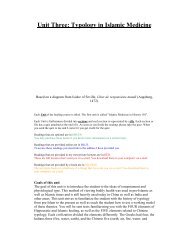Beginning Iridology Guide - Weebly
Beginning Iridology Guide - Weebly
Beginning Iridology Guide - Weebly
Create successful ePaper yourself
Turn your PDF publications into a flip-book with our unique Google optimized e-Paper software.
9. Name four ways you can use a Jensen iris reading.<br />
10. As you were looking at the irises of your family and friends list four<br />
“warnings to iridologists that YOU used” and why. For example, some people<br />
tend to concentrate intensely and thus may have been reminded to let their<br />
subject rest by the rule of not looking in anyone’s eyes too long. What “rules”<br />
do you think will help you be a better iridologist?<br />
11. As you looked at the irises of your friends you may have noticed many<br />
markings. What markings stood out in these people’s eyes? Please list the first<br />
names (or assumed names) of four of these people. After that list the following<br />
under their name:<br />
a. Color of their iris<br />
b. Main characteristic you noticed in their iris<br />
c. Three things you told them<br />
d. What was their response<br />
Chapter 2: Charts & Color in the Iris<br />
These next two chapters are a combination of my writings and some excerpts from a<br />
book by Henry Lindlahr, published in 1919. His book is still applicable today and I<br />
use it as an illustration of how timeless iridology is. I also use excerpts from his book<br />
to present a more detailed look at some aspects of iridology. I have highlighted his<br />
book in blue. Another thing I hope my students learn from his book is that we are<br />
never free from deception or poisons. Today many people are convinced that all these<br />
“problems of old” are gone and that poisonous food additives are a thing of the past,<br />
etc..However, that will probably never be so. There will always be new drugs and new<br />
additives and instead of believing that we are safe, we must develop the habit of being<br />
aware.<br />
Charts and Methods in <strong>Iridology</strong><br />
<strong>Iridology</strong> has been used since the beginning of time but historically charts have<br />
changed and been more refined in modern times. At the same time different charts<br />
have been in use around the world and even today there are slight differences in<br />
iridology charts that are in use. In addition, a new kind of chart is being developed<br />
that is based on a field called “eyeology”. This chart combines the personality<br />
analysis skills of the Rayid chart with the physical analysis information of the Jensen<br />
chart and much more to provide an even more holistic view of the iris being viewed.<br />
However, one must always have a grasp on what has happened in history and what<br />
other charts are available. In this course I will be using mostly the Jensen chart.<br />
However, when I do consulting myself I also use the British chart, especially when<br />
what I see in the person’s eyes does not make sense according to what they have told<br />
me.




